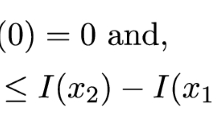Abstract
Models of the insurance markets and institutions are routinely based on expected utility. Since EU is being challenged by an increasing number of decision models, we examine whether EU-based models are robust in their predictions. To do so, we rework some basic models of optimal insurance contracts and equilibrium using the “dual” theory to EU of Yaari. When there is a single, insurable source of risk, dual theory permits only corner solutions if the contract itself is linear. This contrasts sharply with EU. Nonlinearity, and thereby the possibility of interior solutions, is introduced in two ways. First, the contract itself is nonlinear, i.e., a deductible insurance policy. Or second, the decision maker is subject to some background risk such as uninsurable risky assets or default of the insurer. When decision problems are subject to nonlinearity, the predictions on optimal insurance are more similar to, though not identical with, those generated with EU.
Similar content being viewed by others
References
Arrow, K. J. (1963). “Uncertainty and the Welfare Economics of Medical Care,”American Economic Review 53, 941–973.
Beenstock, M., G. Dickinson, and S. Khajuria. (1988). “The Relationship Between Insurance Premiums and Income: An International Analysis,”Journal of Risk and Insurance 55, 259–272.
Borch, K. (1962). “Equilibrium in a Reinsurance Market,”Econometrica 30, 424–444.
Briys, E, G. Dionne, and L. Eekhoudt. (1989). “More on Insurance as a Giffen Good,”Journal of Risk and Uncertainty 2, 415–420.
Chew, S.M. (1985) “An Axiomatization of Rank Dependent Quasilinear Mean, Generalizing the Gini Mean and the Quasilinear Mean” John Hopkins Working Paper #156.
Doherty, N. A., and H. Schlesinger. (1983). “Optimal Insurance in Incomplete Markets,”Journal of Political Economy 91, 1045–1054.
Doherty, N. A., and H. Schlesinger. (1990). “Rational Insurance Purchasing: Consideration of Contract Nonperformance,”Quarterly Journal of Economics 243–253.
Kahneman, D., and A. Tversky. (1979). “Prospect Theory: An Analysis of Decision under Risk,”Econometrica 47, 263–291.
Karni, E. (1992). “Optimal Insurance: An Expected Utility Analysis.” In G. Dionne (ed.),Contributions to Insurance Economics Boston, MA: Kluwer Academic Publishers.
Machina, M. (1994). “Non Expected Utility and the Robustness of the Classical Insurance Paradigm.” Paper presented at the 21st Seminar of the Geneva Association, Toulouse.Geneva Papers in Risk and Insurance Theory, forthcoming.
Mayers, D., and C. W. Smith, Jr. (1983). “The Interdependence of Individual Portfolio Decisions and the Demand for Insurance,”Journal of Political Economy 91, 304–311.
Merrill, C., and N. A. Doherty. (1994). “Monlighting and Deductibles: Adverse Selection and Non-Observable Contracts.” Working paper, Wharton School, University of Pennsylvania.
Mossin, J. (1968). “Aspects of Rational Insurance Purchasing,”Journal of Political Economy 76, 553–568.
Quiggin, J. (1982). “A Theory of Anticipated Utility,”Journal of Economic Behavior and Organization 3, 323–343.
Roell, A. (1987). “Risk Aversion in Qiggin and Yaari's Rank-Order Model of Choice under Uncertainty,”Economic Journal 97, 143–159.
Rothschild, M., and J. Stiglitz. (1976). “Equilibrium in Insurance Markets: An Essay on the Economics of Imperfect Information,”Quarterly Journal of Economics 90, 629–649.
Segal, U. (1989), “Anticipated Utility: A Measure Representation Approach”Annals of Operations Research.
Shavell, S. (1979). “On Moral Hazard and Insurance,”Quarterly Journal of Economics 93, 541–62.
Smith, V. L. (1968). “Optimal Insurance Coverage,”Journal of Political Economy 76, 68–77.
Spence, M. (1977). “Product Differentiation and Performance in Insurance Markets,”Journal of Public Economics 10, 427–447.
Stiglitz, J. (1983). “Risk, Incentives and Insurance: The Pure Theory of Moral Hazard,”Geneva Papers on Risk and Insurance, 8, 4–33.
Turnbull, S. M. (1983). “Additional Aspects of Rational Insurance Purchasing,”Journal of Business 56, 217–229.
Wilson, C. (1977). “A Model of Insurance Markets with Incomplete Information,”Journal of Economic Theory 16, 167–207.
Yaari, M. E. (1987). “The Dual Theory of Choice under Risk,”Econometrica, 55, 95–115.
Author information
Authors and Affiliations
Rights and permissions
About this article
Cite this article
Doherty, N.A., Eeckhoudt, L. Optimal insurance without expected utility: The dual theory and the linearity of insurance contracts. J Risk Uncertainty 10, 157–179 (1995). https://doi.org/10.1007/BF01083558
Issue Date:
DOI: https://doi.org/10.1007/BF01083558



